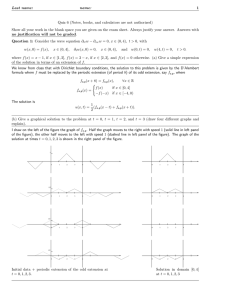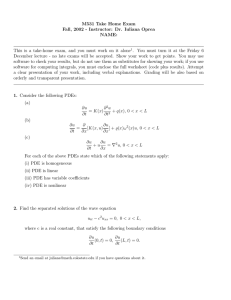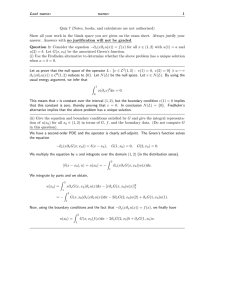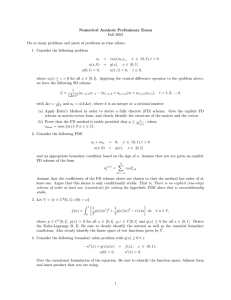Last name: name: 1 Quiz 6 (Notes, books, and calculators are not authorized)
advertisement
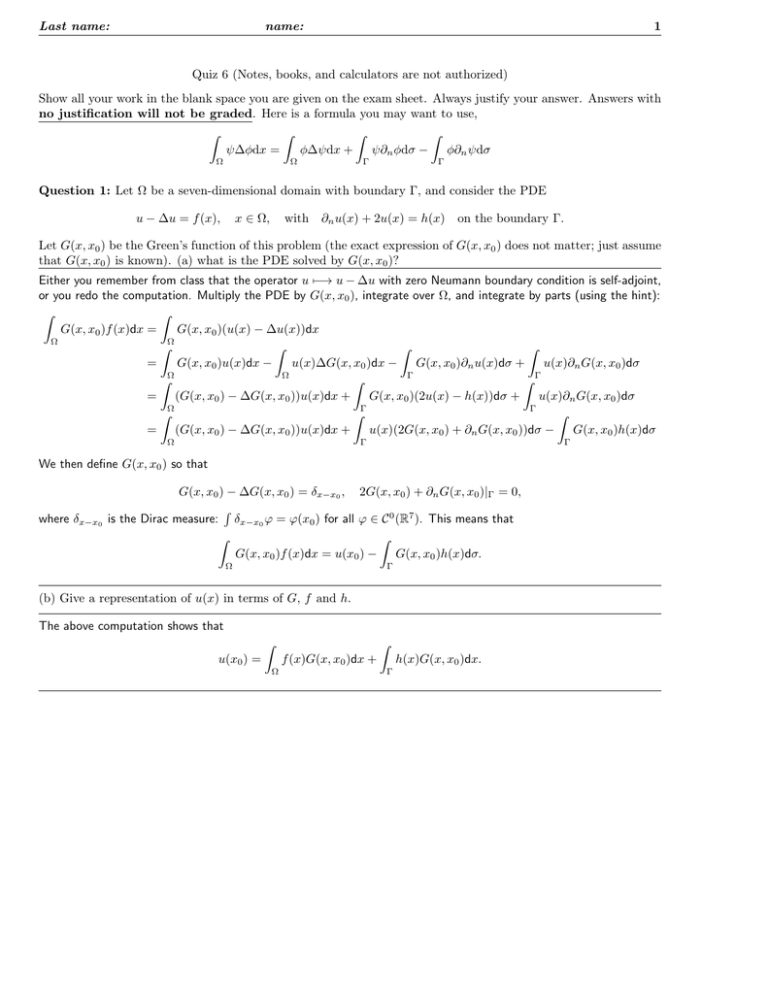
Last name: name: 1 Quiz 6 (Notes, books, and calculators are not authorized) Show all your work in the blank space you are given on the exam sheet. Always justify your answer. Answers with no justification will not be graded. Here is a formula you may want to use, Z Z Z Z ψ∆φdx = φ∆ψdx + ψ∂n φdσ − φ∂n ψdσ Ω Ω Γ Γ Question 1: Let Ω be a seven-dimensional domain with boundary Γ, and consider the PDE u − ∆u = f (x), x ∈ Ω, with ∂n u(x) + 2u(x) = h(x) on the boundary Γ. Let G(x, x0 ) be the Green’s function of this problem (the exact expression of G(x, x0 ) does not matter; just assume that G(x, x0 ) is known). (a) what is the PDE solved by G(x, x0 )? Either you remember from class that the operator u 7−→ u − ∆u with zero Neumann boundary condition is self-adjoint, or you redo the computation. Multiply the PDE by G(x, x0 ), integrate over Ω, and integrate by parts (using the hint): Z Z G(x, x0 )f (x)dx = G(x, x0 )(u(x) − ∆u(x))dx Ω ZΩ Z Z Z = G(x, x0 )u(x)dx − u(x)∆G(x, x0 )dx − G(x, x0 )∂n u(x)dσ + u(x)∂n G(x, x0 )dσ Ω Γ ZΩ Z ZΓ = (G(x, x0 ) − ∆G(x, x0 ))u(x)dx + G(x, x0 )(2u(x) − h(x))dσ + u(x)∂n G(x, x0 )dσ Γ ZΩ ZΓ Z = (G(x, x0 ) − ∆G(x, x0 ))u(x)dx + u(x)(2G(x, x0 ) + ∂n G(x, x0 ))dσ − G(x, x0 )h(x)dσ Ω Γ Γ We then define G(x, x0 ) so that where δx−x0 G(x, x0 ) − ∆G(x, x0 ) = δx−x0 , 2G(x, x0 ) + ∂n G(x, x0 )|Γ = 0, R is the Dirac measure: δx−x0 ϕ = ϕ(x0 ) for all ϕ ∈ C 0 (R7 ). This means that Z Z G(x, x0 )f (x)dx = u(x0 ) − G(x, x0 )h(x)dσ. Ω Γ (b) Give a representation of u(x) in terms of G, f and h. The above computation shows that Z u(x0 ) = Z f (x)G(x, x0 )dx + Ω h(x)G(x, x0 )dx. Γ 2 Quiz 6, March 20, 2014 Question 2: Consider the equation ∂xx u(x) = f (x), x ∈ (0, L), with u(0) = a and ∂x u(L) = b. (a) Compute the Green’s function of the problem. Let x0 be a point in (0, L). The Green’s function of the problem is such that ∂xx G(x, x0 ) = δx0 , G(0, x0 ) = 0, ∂x G(L, x0 ) = 0. The following holds for all x ∈ (0, x0 ): ∂xx G(x, x0 ) = 0. This implies that G(x, x0 ) = ax + b in (0, x0 ). The boundary condition G(0, x0 ) = 0 gives b = 0. Likewise, the following holds for all x ∈ (x0 , L): ∂xx G(x, x0 ) = 0. This implies that G(x, x0 ) = cx + d in (x0 , L). The boundary condition ∂x G(L, x0 ) = 0 gives c = 0. The continuity of G(x, x0 ) at x0 implies that ax0 = d. The condition Z ∂xx G(x, x0 )dx = 1, ∀ > 0, − − gives the so-called jump condition: ∂x G(x+ 0 , x0 ) − ∂x G(x0 , x0 ) = 1. This means that 0 − a = 1, i.e., a = −1 and d = −x0 . In conclusion ( −x if ≤ x ≤ x0 , G(x, x0 ) = −x0 otherwise. (b) Give the integral representation of u using the Green’s function. Let x0 be a point in (0, L). The definition of the Dirac measure at x0 is such that u(x0 ) = hδx0 , ui = h∂xx G(·, x0 ), ui Z L L =− ∂x G(x, x0 )∂x u(x)dx + [∂x G(x, x0 )u(x)]0 Z 0 L 0 Z L L G(x, x0 )∂xx u(x)dx − [G(x, x0 )∂x u(x)]0 + [∂x G(x, x0 )u(x)]0 = L G(x, x0 )f (x)dx − G(L, x0 )∂x u(L) + G(0, x0 )∂x u(0) + ∂x G(L, x0 )u(L) − ∂x G(0, x0 )u(0). = 0 This finally gives the following representation of the solution: Z L G(x, x0 )f (x)dx − G(L, x0 )b − ∂x G(0, x0 )a u(x0 ) = 0
